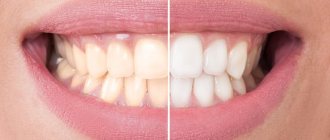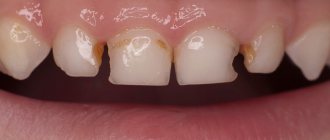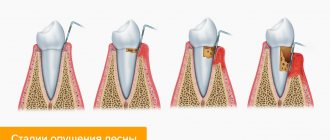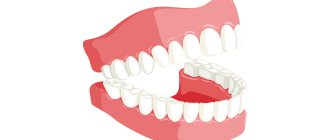Unfortunately, due to many reasons, such health problems occur that teeth simply crumble. This can occur at different ages, with baby teeth in children and permanent teeth in adults. What to do? Of course, you should see a doctor. Go to the dentist, and after the examination he can refer you to a specialist and advise you to undergo an examination.
Symptoms
It is difficult to miss such a fact when a tooth has crumbled. This usually occurs while eating, and a hard piece of enamel is felt in the mouth. Sometimes there are many small pieces at once. There is a feeling of panic. After all, we know from school that enamel is the hardest tissue in the body. Why does this happen, causing teeth to crumble and crack?
It happens that it all starts with stains on the enamel - this is a symptom that not everything is in order. And you need to make a visit to the dentist before the crown of the tooth collapses.
Treatment Options
Therapy should begin after the cause has been identified and eliminated. Treatment should be general (at the body level) and local (in the oral cavity). General - may include: eliminating bad habits, sanitizing the body and oral cavity, taking vitamins, proper nutrition. Local treatment will depend on the severity of the pathology and the number of lost teeth. Therapy can be carried out in the following ways:
- Install a filling - if the tooth begins to deteriorate or part of it is missing;
- Make a restoration to restore appearance and color;
- Install a crown when a significant part of the hard tissue is lost;
- Make a prosthesis after root loss;
- If teeth crumble and fall out, they can be restored using implantation.
Reasons why teeth may crumble
The answer to the question of why teeth crumble in an adult or child can be not only in the field of dentistry, but also much deeper, and everything is reflected in the condition of the dentition.
Causes:
- poor
oral hygiene. And no matter how they say that everyone always talks about the importance of the procedure, it is so. An acidic environment has a destructive effect on enamel, making it fragile and vulnerable. Increased acidity is affected by plaque on the teeth, which is where bacteria and their waste products—destructive acid—accumulate; - untreated caries
and other diseases, when there is a lot of carious tissue and the walls of the tooth become thinner. As a result, the tooth began to crumble; - mechanical causes
: trauma, super-hard food - nuts, chewing candy, etc., bad habits - chewing pencils, objects, opening a bottle with your teeth. As a result, the tooth cracked and broke; - changes in
food temperature. Very hot suddenly gives way to cold. The enamel does not withstand, cracks appear; - lack of vitamins
and minerals: calcium, vitamin D (which promotes the absorption of calcium), fluorine, phosphorus; - metabolic disease
. It is worth visiting an endocrinologist; - hormonal imbalance
. These are not only diseases associated with hormonal levels and fluctuations, but also special periods in a person’s life - adolescence and old age, menopause, pregnancy; - heredity
. Genetic predisposition to weak enamel; - stress
; - malocclusion
- uneven load on the lower and upper teeth; - Bruxism
is involuntary grinding of teeth during the day or at night.
Video from our expert about how and why teeth decay:
Teeth quickly decay due to chronic diseases, diseases of the gastrointestinal tract and endocrine glands. And crumbling teeth is a signal that needs to be responded to urgently.
Prevention of tooth decay in adults
Careful care will help keep your teeth healthy. It consists of a number of factors, including concerns about nutrition and lifestyle.
In addition, it is important to purchase:
- toothbrush, soft or medium hard. Do not forget that the brush should be changed regularly;
- threads and rinsing gels;
- toothpaste selected after consultation with a dentist.
Bad habits are worth fighting. This applies not only to smoking or alcohol, but also to clicking teeth, chewing crackers, pistachios and other hard foods.
If involuntary teeth grinding occurs, you will need the help of a neurologist. In most cases, the solution to the problem is mouthguards and sedatives (they are used only as prescribed by a doctor).
Try to enrich your diet with seafood, fresh vegetables, cottage cheese, and fruits. For rinsing (and it is better to do it after each meal), use special products. And don’t forget about the importance of preventive examination: you need to visit the dentist once every six months.
Number of views 10,786
Teeth began to crumble during pregnancy
For the development of the fetus, calcium is necessary, which the child receives from the body of the expectant mother. A woman experiences a deficiency if she does not eat well and does not take it additionally in the form of supplements or mineral complexes. Teeth may be destroyed, which occurs quite often in this “interesting position.”
The next factor influencing the weakness of dental tissue may be a hormonal surge during pregnancy and the nervousness of the mother.
Necessary:
- take care of a sufficient supply of calcium
in the body, because it also affects the development of the skeletal system (including the rudiments of teeth) of the unborn child. Eat a balanced diet, if necessary, take active supplements with calcium and vitamin D prescribed by your doctor; - don’t be nervous,
and walk more - be observed
during pregnancy by a gynecologist, dentist, or other doctors, if indicated.
Teeth can crumble not only during pregnancy, but also during lactation. With mother's milk, calcium is transferred to the baby.
Content:
- Reasons why teeth crumble 1.1. Caries 1.2. Fluorosis 1.3. Erosion of teeth 1.4. Bruxism 1.5. Genetic predisposition 1.6. Unsatisfactory working conditions and poor environment
- What to do if your teeth start to crumble badly
- If there is nothing left of the tooth
Many people face the problem of decaying teeth. At some point, a piece of the unit breaks off, causing its appearance to change significantly. Below we will tell you why this happens and what to do if the tooth crumbles.
How to get rid of the problem, solution methods
The dentist will decide how to stop tooth decay after identifying the cause. If treatment by other doctors is necessary, then in parallel it is already possible to begin the restoration of dental units.
Dental restoration methods:
- filling.
Installing a filling in place of the missing piece of tissue. If the carious cavity is large enough and the walls are fragile, then an inlay with a composite material may be indicated; - veneers.
If there is a chip or crack in the front teeth of the frontal area, a thin ceramic overlay will correct the situation, hiding all the defects; - crowns
When the crown of a tooth is severely damaged, the doctor may recommend installing an artificial one from the selected material. Most often these are metal ceramics, ceramics, zirconium dioxide. It is important what condition the gums are in; - remineralization.
Restoring the normal balance of vitamins in the enamel structure. A special composition is applied to the surface of the teeth for several minutes. The tissue is saturated, enriched with calcium, fluoride, becomes stronger and can even remove caries at the chalk spot stage; - fluoridation.
Fluoride-containing pastes nourish the enamel. Fluorine is responsible for crystalline calcium compounds. Fluoride varnish seals dentinal tubules, strengthening teeth; - taking active
calcium and vitamin D
The ecological situation of the region of residence is one of the causes of dental health pathologies. The quality of air, water and food is far from ideal. Replenish the deficiency with complex supplements, spend your weekends in nature. Love organic farm products.
How to fix crumbling teeth
Once the cause is determined, treatment begins. If the condition of the teeth worsens due to diseases occurring in the body, the teeth are restored last - after other affected areas have been treated.
If the source of the problem lies in the oral cavity, the doctor may suggest several treatment options.
- Filling.
Caries or injuries lead to chips of varying sizes. They are removed with a filling.
- Crowns, veneers.
In case of serious damage to teeth, when filling does not help, it is recommended to install artificial crowns and veneers - porcelain or ceramic overlays.
- Mineralization.
A strengthening procedure during which applications containing calcium and fluoride are applied to damaged teeth.
- Fluoride coating of teeth.
The procedure also strengthens the enamel, but special fluoride-containing pastes are used.
- Taking multivitamins and nutritional supplements.
Installing veneers (onlays) is one of the ways to correct dental defects
What to do if the tooth is completely crumbled
The crown part of the tooth has completely crumbled, what should I do? You must make an appointment with a doctor at a dental clinic within two days. After the x-ray, it will be clear whether the root is preserved, what condition it is in, and whether removal is necessary. Then possible recovery options:
- prosthetics (stump inlays, pins, crowns and bridges);
- implantation (implantation of a titanium artificial root into bone tissue followed by installation of a crown).
In any case, modern techniques are sufficient to compensate for any loss of teeth.
What to do to strengthen enamel
Once the cause of the disease is determined, the doctor prescribes treatment. If the cause of tooth decay is untreated caries or mechanical damage, then the issue can be solved with the help of prosthetics. If the problem is a lack of vitamins or changes in hormonal levels, then specialized specialists will be involved in the treatment process.
When is it time to sound the alarm? Symptoms and stages of tooth decay
There are a number of signs that should alert you. Having noticed one or two of them, a person should become concerned and see a specialist. This:
- 1. Accumulation of plaque on tooth enamel. Barely noticeable yellowish spots.
- 2. Bad breath, even the smell of rotten breath. With severe caries, the smell will be very noticeable.
- 3. Dark spots on the enamel. Painful sensations when eating hot or cold, sweet foods.
- 4. If you ignore the above-mentioned manifestations of ill health, the situation gets worse. Next, black areas appear in the area of the neck of the tooth or on the root itself, but the latter can only be detected during an X-ray examination.
- 5. Frequent aching painful sensations appear, and even if you regularly rinse your mouth with herbal infusions and take painkillers, the destructive processes are in full swing.
- 6. The pain intensifies (especially when a stream of cold air hits the tooth), and the pulp begins to die.
- 7. The nerve bundle is affected, the pain becomes especially severe.
- 8. Then, if the person never went to the hospital, he notices with surprise and relief that the pain goes away. However, in reality, the inflammatory process does not stop - the disease spreads to the root area.
Incorrectly restored tooth
- Poor performance of the filling , violation of technology and methodology during restoration (we will not dwell on this).
- The type of restoration is inadequately selected, in a word, “too big a filling” (i.e. they put a filling in cases where it can no longer be placed, but there are all the indications for “more serious” ceramic restorations (inlays, crowns).
I would like to dwell on the second reason in more detail.
Competent dentists know that there is an index of tooth surface destruction (DSI), which must be taken into account before restoring teeth in order to do it correctly. For you, dear patient, I will describe it in a simplified way. If the tooth is not severely damaged (conditionally up to 40% of the surface), a filling is an excellent way to restore it. Destruction of 40 to 70% of the surface requires the manufacture of a ceramic inlay or strengthening of the tooth with various pin structures.
If there is a significant degree of destruction of the tooth surface (more than 70%), the tooth should be correctly restored with a crown. In a word, the type of tooth restoration depends on the degree of destruction.
What's wrong with a filling?
Each recovery method has its own indications. So, a filling is necessary and can be placed in cases of small and medium degrees of tooth decay. If the decay is significant, a large filling can split the tooth in half.
Let's find out why!
Any material (even metal) expands when heated (remember the temperature of the tea you drink!). Temperature changes are a fairly common occurrence that our teeth encounter (from hot tea to ice cream). The coefficient of thermal expansion of filling materials is still higher than that of tooth tissue. That is, when hot food is consumed, the filling expands more than the tooth tissue that surrounds it. The larger the volume of the filling, the greater the expansion (this is why a large volume of the filling is so undesirable).
Of course, this expansion is minimal, not noticeable to any eye and not perceptible. However, add to it a chewing load (which far exceeds temperature deformations), a large filling, thinned tooth tissue, and the likelihood of chipping increases many times over.
Unlike filling materials, ceramics (from which crowns and inlays are made) have a closer coefficient of thermal expansion to the tooth tissues, and therefore do not contribute to its chipping. In addition, it is stronger. That is why it is correct to restore severely damaged teeth not with fillings, but with ceramic restorations. There are other physical phenomena that affect the change in the size of the filling and, as a result, the splitting of the tooth.
All of the above, of course, is true only with an adequately completed restoration (even fillings, even crowns). An inaccurate hand of a master can lead to chipping even with ceramic restorations, and on the contrary, a skillful hand can place a large filling so that it will last a long time. However, there is a limit to everything and it is better not to go beyond the indications for restorations if you want to get guaranteed and reliable work.
Conclusion : you should not expand the indications for conventional fillings too much; they are not capable of qualitatively restoring a badly damaged tooth. But in case of minor tooth decay, fillings have proven themselves to be excellent!
Let me give you a photographic example.
The patient complained that it was painful for her to bite on one of her teeth, that something “crunched” in it.
Upon examination, we determined: tooth 4 on the upper jaw: it has a medium-sized filling (at first glance). And a movable, broken tooth wall, which is held together only by the gums. This wall is no longer attached to the tooth.
The broken fragment of the tooth is mobile, easily moved to the side, but has not yet been removed.
View of the tooth after removing the broken wall: the cheek wall was chipped under the gum. A large filling and a thin remaining tooth wall on the palatal side are visible. Some doctors may try to restore such a tooth using a crown (with preliminary extension); some doctors will offer a perhaps more predictable option: removal and subsequent implantation.
Why are teeth restored incorrectly?
It’s absurd, but often the dentist follows the patient’s lead. The patient, not fully understanding all the subtleties and features of the distribution of the load when chewing, refuses the inlay or crown and asks the doctor to “put a filling”, they say, I’ll work with it a little more, and only then the crown! As a result, at the most inopportune moment, a “piece” of the tooth breaks off. As a result, such “pity” of the doctor for the patient turns out to be a bigger problem for the patient than timely adequate tooth restoration.
By clicking on the “Make an appointment” button, I consent to the processing of my personal data.
I have read and agree with the conditions for processing personal data set out on the website ds-chocolate.ru.
Consent to the processing of personal data
How to properly restore teeth?
When treating a tooth, the doctor must remove all carious tissues, old fillings, movable walls, if any, completely clean the tooth and only then assess the degree of destruction (which walls and cusps have survived, whether they are able to bear the load, how the load on this tooth will be distributed during different methods of restoration, whether chips of any wall are possible, whether its restoration will lead to a split of the root, etc.). After such an assessment, it is determined how to properly restore the tooth: is it possible to put a filling, or does it need to be “strengthened with a pin,” or would it be more correct to use a ceramic inlay or a crown.
Conclusion: a properly selected restoration will preserve the tooth for many years, protect it from further destruction, and the patient from having to redo the work in a few years.
Tip #2: Avoid home enamel whitening procedures
Many people are too zealous in pursuit of a beautiful snow-white smile. They begin to experiment at home with inexpensive and at the same time very unsafe means: activated carbon, soda, lemon. All these products, when used irrationally (and this is how they are most often used in the hope of a tangible result), injure and weaken the enamel, causing cracks to appear on it.
If you want to whiten your teeth, there is nothing safer than professional whitening in the dentist's office. However, if you prefer to experiment with traditional recipes, then it is best to choose those that are not aggressive and at least will not harm the enamel. For example, banana peel or tea tree oil.
Basic methods of dental restoration
Modern dentistry offers several solutions for restoring damaged teeth.
- Filling. If a premolar or molar is less than 50% destroyed, a filling can be placed. Carious cavities are cleaned and dried. Large fillings are installed on anchors or fiberglass pins.
- Prosthetics. If the tooth is severely damaged, it is treated, ground and a crown is installed - metal-ceramic, ceramic or zirconium dioxide. In case of deep caries, it may be necessary to clean the canals and install a stump tab to fix the crown.
If the natural tooth cannot be saved, it should be removed and an appointment for implantation should be made. You can place an implant with a temporary crown immediately after extraction. There is also a classic implantation option - an artificial structure is implanted 2-3 months after tooth extraction. It is important to know that after extraction of a molar or premolar, bone tissue rapidly decreases, so you should not delay implantation for long, since osteoplasty may be required after a year.
Rotten teeth: consequences for the body
A rotten black tooth is a direct path to the dentist. The doctor will make a diagnosis and provide treatment. But what happens if you don’t remove a rotten tooth? In cases where the tooth has rotted down to the gum, the consequences will affect the patient’s entire body:
- constant fatigue, apathy, frequent colds and ARVI - due to general intoxication due to infection and decreased immunity;
- deterioration of heart function - development of the disease endocarditis, inflammation of the inner lining of the heart;
- problems with the gastrointestinal tract - loss of appetite, gastritis, ulcers, dysbacteriosis;
- damage to the trigeminal nerve - chronic migraines, memory impairment, Alzheimer's disease;
- disruption of the musculoskeletal system - development of arthrosis, polyarthritis;
- problems with appearance - hair loss, deterioration of skin condition;
- decreased hearing quality.
A serious consideration of the question of what rotten teeth affects demonstrates the interdependence of all organs and parts of the human body. Deterioration of the oral cavity is a path to heart attack, thrombosis, abscesses and other diseases.
Comments
I read somewhere that insufficient dental care, i.e. Ignoring daily brushing can cause your teeth to begin to crumble. I don't understand what the connection is here? If I skip brushing my teeth once, will they immediately crumble? It doesn’t happen that way...
Valentina (06.11.2019 at 01:11) Reply to comment
- Dear Valentina! If you skip brushing your teeth once or skip it periodically, plaque will begin to accumulate on the enamel. Over time, it turns into a hard stone that can no longer be removed on your own. And this is a source of nutrition for bacteria that lead to caries, pulpitis, periodontitis and other dental diseases that already destroy teeth and contribute to the fact that they can begin to crumble.
Editorial staff of the portal UltraSmile.ru (09.11.2019 at 09:14) Reply to comment
The body is not always able to extract valuable elements from food alone, if only because their content in individual products can be negligible. Vitamin and mineral complexes will come to the rescue - if selected correctly, they will provide your body with an invaluable service. Firstly, you will not receive one micronutrient, as is the case with “monopreparations,” but several at once. Secondly, in most modern formulations the components are balanced in such a way
Nastya (02/14/2021 at 10:00) Reply to comment
Write your comment Cancel reply
Injury
Single or chronic - the third reason for possible tooth chips
A single injury occurs when there is a blow, an accident, or accidentally biting on a hard object while chewing.
There are three types of chronic injury
- Due to malocclusion (when the teeth do not close correctly, some teeth may receive excessive load, close in the wrong areas, at the wrong angle, or with an opponent that is not their power). For example, a powerful fang of the lower jaw can be positioned in such a way that when closed, it will severely injure the incisor on the upper jaw, which is much inferior to it in size and power. As a result of such long-term closure, the incisor can get into big problems, and the patient will face the need for treatment or removal.
- Due to the absence of other teeth (when a number of teeth are missing, their work is performed by the remaining ones; excessive load may one day result in a fracture of the tooth, a break in its wall, or a split in the root).
- Due to bruxism (“idle” teeth grinding) or other parafunctional manifestations.
How to avoid?
- Be sure to restore missing teeth (there are a lot of ways today, there are even temporary prosthetics if for some reason you need to postpone dental treatment).
- Consult an orthodontist, orthopedist or periodontist about bite problems and undergo orthodontic treatment if indicated.
- Get advice from an orthopedist/gnathologist and psychotherapist about the possible causes of bruxism and take possible measures that the doctor recommends.
Tip #5: Say goodbye to bad habits
Of course, smokers, even if their teeth have crumbled, are unlikely to immediately give up this bad habit. But it’s still worth keeping it to a minimum. Plus, enrich your diet with vitamin C (the daily intake for smokers should be 2 times higher than for others).
The bad habit of chewing on a pen can injure your teeth.
However, in addition to smoking and alcohol, there are also a lot of other harmful everyday habits, and some of them have already become so part of our everyday life that they are carried out almost at the level of unconditioned reflexes. For example, chewing on a pen or pencil while working or studying, or chewing on floss with your teeth.
There are other everyday habits that are important to get rid of if you don’t want to damage your enamel: opening bottles with your teeth, chewing seeds and nuts, crackers, biting your nails.
Notice
: Undefined variable: post_id in
/home/c/ch75405/public_html/wp-content/themes/UltraSmile/single-item.php
on line
45 Notice
: Undefined variable: full in
/home/c/ch75405/public_html/wp-content /themes/UltraSmile/single-item.php
on line
46
Rate this article:
( 5 ratings, average: 4.00 out of 5)
prevention
- Iozefovich O.V., Ruleva A.A., Kharit S.M., Muravyova N.N. Choosing vitamins, 2010
Expert “Many people use highly abrasive pastes to lighten enamel, but not in courses of 2-3 weeks, as expected, but on an ongoing basis. Plus, they press the brush quite hard during oral hygiene. At the same time, they completely do not take into account the original condition of their teeth. All this together leads to bad consequences and to an effect that is exactly the opposite of what was expected - the enamel becomes dull, becomes very brittle and is destroyed.” Dentist-therapist Elena Vladimirovna Orlova
Consulting specialist
Orlova Elena Vladimirovna
Doctor rating: 9.5 out of 10 (2) Specialization: Dentist-therapist Experience: 32 years











